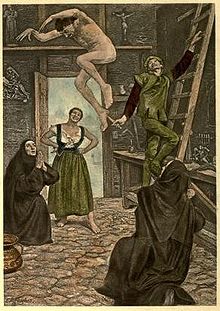The Facetious Nights of Straparola (1550–1555; Italian: Le piacevoli notti), also known as The Nights of Straparola, is a two-volume collection of 75[1] stories by Italian author and fairy-tale collector Giovanni Francesco Straparola. Modeled after Boccaccio's Decameron, it is significant as often being called the first European storybook to contain fairy-tales;[2] it would influence later fairy-tale authors like Charles Perrault and Jacob and Wilhelm Grimm.

Night the Ninth, Sixth Fable
Watercolor by E. R. Hughes
The Italian Novelists, Volume 3
History
The Facetious Nights of Straparola was first published in Italy between 1550–53[1] under the title Le piacevoli notti ("The Pleasant Nights") containing 74 stories. In 1555 the stories were published in a single volume in which one of the tales was replaced with two new tales, bringing the total to 75.[1] Straparola was translated into Spanish in 1583. In 1624 it was placed on the Index of Prohibited Books.[1]
The work was modeled on Boccaccio's Decameron with a frame narrative and novellas, but it took an innovative approach by also including folk and fairy tales.[1] In the frame narrative, participants of a party on the island of Murano, near Venice, tell each other stories that vary from bawdy to fantastic.[3] The narrators are mostly women, while the men, among whose ranks are included historical men of letters such as Pietro Bembo and Bernardo Cappello, listen.[1] The 74 original tales are told over 13 nights, five tales are told each night except the eighth (six tales) and the thirteenth (thirteen tales).[1] Songs and dances begin each night, and the nights end with a riddle or enigma.[1] The tales include folk and fairy-tales (about 15); Boccaccio-like novellas with themes of trickery and intrigue; and tragic and heroic stories.[1]
The 15 fairy tales were influential with later authors, some were the first recorded instances of now-famous stories, like "Puss in Boots".[1] Many of the tales were later collected or retold in Giambattista Basile’s The Tale of Tales (1634–36) and Jacob and Wilhelm Grimm's Grimm's Fairy Tales (1812–15).[1]
Fairy tales
Fairy tales that originally appeared in Nights of Straparola, with later adaptations by Giambattista Basile, Madame d'Aulnoy, Charles Perrault, Carlo Gozzi, Jacob and Wilhelm Grimm.[4]
Footnotes
References
Further reading
- Ruth B. Bottigheimer, Fairy Godfather: Straparola, Venice, and the Fairy Tale Tradition (University of Pennsylvania Press, 2002).
External links

- The Nights of Straparola, trans. W.G.Waters 1894. Scanned original color illustrated editions.
- The Italian Novelists (vol. 1–4), trans. W.G.Waters 1901–04. Scanned original color illustrated editions. Note: this edition differs slightly in content from the 1894 edition.
- SurLaLune Fairy Tale Pages: The Facetious Nights of Straparola